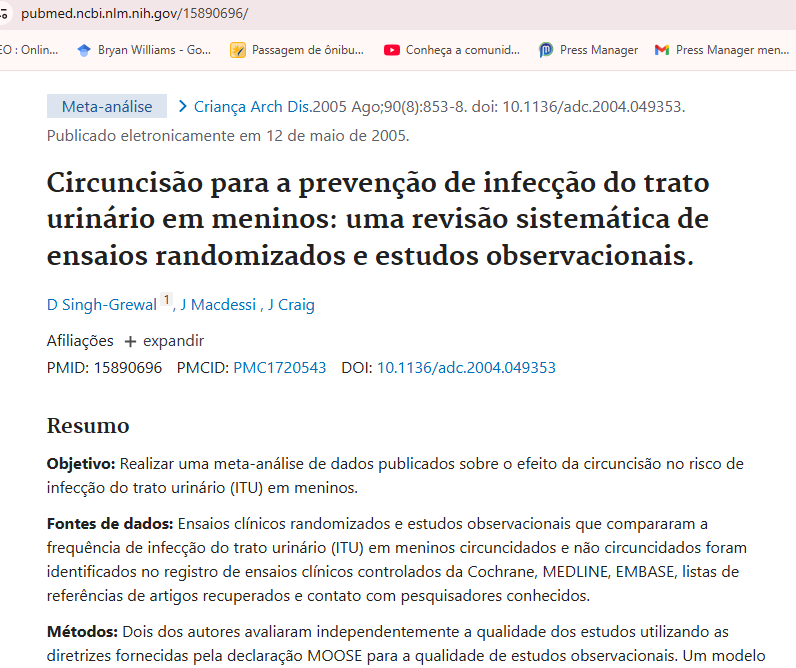Resultados Gerais e Benefícios
https://pubmed.ncbi.nlm.nih.gov/15890696/

- Redução do Risco de ISTs: Vários estudos, incluindo ensaios controlados randomizados (ECRs), demonstraram que a circuncisão masculina (CM) reduz o risco de adquirir várias infecções sexualmente transmissíveis (ISTs), incluindo HIV, herpes genital, papilomavírus humano (HPV), sífilis, Trichomonas vaginalis, entre outras. Uma meta-análise mostrou reduções de risco de 43% para HPV de alto risco e 33%.
- Proteção Contra Infecções: A circuncisão protege contra infecções do trato urinário (ITU), especialmente no primeiro ano de vida. Uma meta-análise observou que 1 em cada 12 homens circuncidados apresenta uma ITU em comparação a 1 em 3 homens não circuncidados ao longo da vida. Também reduz o risco de balanite (inflamação do glande) e balanopostite (inflamação do prepúcio e do glande).
- Redução do Risco de Certos Cânceres: A circuncisão está associada a um menor risco de câncer peniano e um menor risco de câncer cervical em parceiras femininas. A CM em recém-nascidos reduz o câncer peniano na vida adulta em 95%-99%.
- Outros Benefícios: A circuncisão pode prevenir fimose (incapacidade de retrair o prepúcio) e paraphimosis (incapacidade de retornar o prepúcio à sua posição original). Também facilita a manutenção da higiene peniana.
Recursos Principais para Encontrar Artigos Científicos
- PubMed: Pesquise no PubMed usando termos como “benefícios da circuncisão”, “resultados de saúde da circuncisão masculina”, “circuncisão e ISTs” e “circuncisão e câncer peniano.” Você pode filtrar seus resultados por data de publicação, tipo de estudo (por exemplo, meta-análise, ensaio controlado randomizado) e outros critérios.
- Revisões Sistemáticas e Meta-Análises: Esses tipos de estudos resumem as descobertas de vários estudos individuais, fornecendo uma visão abrangente das evidências. Procure por revisões sistemáticas e meta-análises sobre circuncisão para ter uma noção do corpo geral de pesquisa.
- Declaração de Política da Academia Americana de Pediatria (AAP): A AAP possui uma declaração de política sobre a circuncisão masculina que é baseada em uma revisão completa das evidências científicas. Essa declaração pode fornecer um bom ponto de partida para sua pesquisa.
- Organização Mundial da Saúde (OMS): A OMS também tem recomendações sobre a circuncisão masculina para a prevenção do HIV. Suas publicações citarão a literatura científica relevante.
Considerações Importantes
- Qualidade do Estudo: Ao avaliar artigos científicos, preste atenção ao desenho do estudo, tamanho da amostra e outros fatores metodológicos. Ensaios controlados randomizados e meta-análises geralmente fornecem as evidências mais robustas.
- Considerações Culturais e Éticas: É importante reconhecer que a circuncisão é um tema sensível com dimensões culturais, religiosas e éticas. A evidência científica deve ser considerada juntamente com esses outros fatores.
- Riscos de Complicações: Embora a circuncisão seja geralmente segura, existem riscos potenciais, como sangramento, infecção e dor. Esses riscos são geralmente baixos quando o procedimento é realizado por um profissional treinado.compile numerous studies supporting the health benefits of circumcision.
General Findings & Benefits
- Reduced Risk of STIs: Numerous studies, including randomized controlled trials (RCTs), have demonstrated that male circumcision (MC) reduces the risk of acquiring several sexually transmitted infections (STIs), including HIV, genital herpes, human papillomavirus (HPV), syphilis, Trichomonas vaginalis, and others [1][2]. A meta-analysis showed risk reductions in high-risk HPV of 43% and 33% [3].
- Protection Against Infections: Circumcision protects against urinary tract infections (UTIs), especially in the first year of life [3][4]. A meta-analysis noted that 1 in 12 circumcised males experience a UTI compared to 1 in 3 uncircumcised males over a lifetime [3]. It also reduces the risk of balanitis (inflammation of the glans) and balanoposthitis (inflammation of the foreskin and glans) [3][4].
- Reduced Risk of Certain Cancers: Circumcision is associated with a lower risk of penile cancer and a lower risk of cervical cancer in female partners [4][5]. Infant MC reduces penile cancer later in life by 95%-99% [3].
- Other Benefits: Circumcision can prevent phimosis (inability to retract the foreskin) and paraphimosis (inability to return the foreskin to its original location) [4]. It also makes it easier to maintain penile hygiene [4][6].
Key Resources for Finding Scientific Articles
- PubMed: Search PubMed using terms like “circumcision benefits,” “male circumcision health outcomes,” “circumcision and STIs,” and “circumcision and penile cancer.” You can filter your results by publication date, study type (e.g., meta-analysis, randomized controlled trial), and other criteria.
- Systematic Reviews and Meta-Analyses: These types of studies summarize the findings of multiple individual studies, providing a comprehensive overview of the evidence. Look for systematic reviews and meta-analyses on circumcision to get a sense of the overall body of research.
- American Academy of Pediatrics (AAP) Policy Statement: The AAP has a policy statement on male circumcision that is based on a thorough review of the scientific evidence [5]. This statement can provide a good starting point for your research.
- World Health Organization (WHO): The WHO also has recommendations regarding male circumcision for HIV prevention [2]. Their publications will cite the relevant scientific literature.
Important Considerations
- Study Quality: When evaluating scientific articles, pay attention to the study design, sample size, and other methodological factors. Randomized controlled trials and meta-analyses generally provide the strongest evidence.
- Cultural and Ethical Considerations: It’s important to acknowledge that circumcision is a sensitive topic with cultural, religious, and ethical dimensions. Scientific evidence should be considered in conjunction with these other factors.
- Complication Risks: While circumcision is generally safe, there are potential risks, such as bleeding, infection, and pain [7][8]. These risks are generally low when the procedure is performed by a trained professional [2].
Learn more:
- The Medical Benefits of Male Circumcision – PMC – NIH
- Circumcision – Wikipedia
- Early infant male circumcision: Systematic review, risk-benefit analysis, and progress in policy – NIH
- Circumcision: Benefits, Risks, and Procedure – WebMD
- Greater Benefits of Infant Circumcision | Johns Hopkins Medicine
- The Medical Benefits of Male Circumcision | Request PDF – ResearchGate
- Male Circumcision Complications – A Systematic Review, Meta-Analysis and Meta-Regression – PubMed
- Male Circumcision Complications – A Systematic Review, Meta-Analysis and Meta-Regression | Request PDF – ResearchGate

